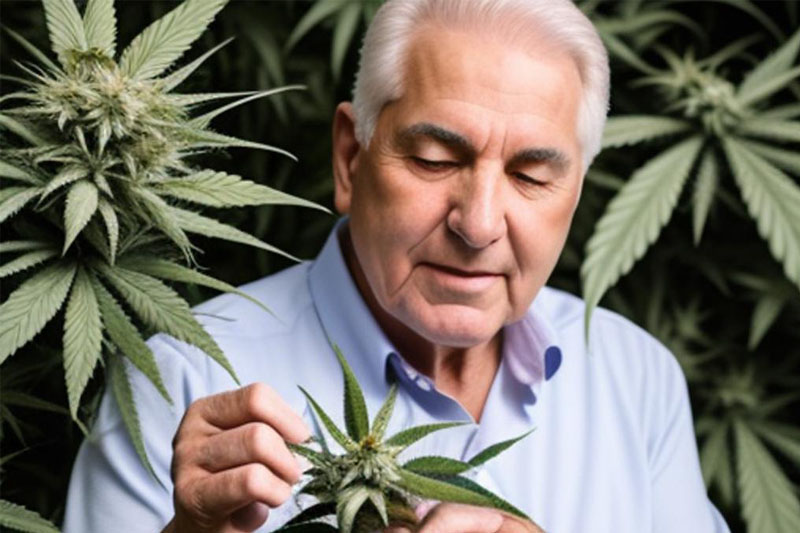Table of Contents
- 1 Understanding the Differences Between Indica, Sativa, and Hybrid Cannabis Strains
- 2 How Indica Strains Can Reduce Inflammation and Pain
- 3 The Science Behind Using Cannabis Indica for Inflammation
- 4 Finding and Choosing the Right Indica Strains and Products
- 5 Best Ways Baby Boomers Can Consume Indica for Arthritis Relief
- 6 Comparing Indica to Prescription Medications for Inflammation and Pain
- 7 Are There Risks or Side Effects for Baby Boomers Using Cannabis Indica?
- 8 FAQ: Answering Common Questions About Using Indica Cannabis Strains for Inflammation
- 9 Conclusion
Last Updated on April 18, 2024 by Team Spinfuel
 Understanding the Differences Between Indica, Sativa, and Hybrid Cannabis Strains
Understanding the Differences Between Indica, Sativa, and Hybrid Cannabis Strains
The cannabis plant comes in three main varieties: Indica, Sativa, and hybrid strains. Indica strains are known for their sedative effects and are often used by those seeking relief from chronic pain, insomnia, and inflammation. As someone with arthritis, I have found Indica strains particularly helpful for mitigating discomfort and improving mobility.
Indica Strains
Indica strains contain higher levels of cannabinoids like cannabidiol (CBD) and lower levels of tetrahydrocannabinol (THC) compared to Sativa varieties. CBD acts as an anti-inflammatory and pain reliever, without the psychoactive effects of THC. Popular Indica strains for inflammation and pain include Granddaddy Purple, Northern Lights, and Afghan Kush.
Sativa Strains
Sativa strains tend to be more uplifting and energizing. They contain higher concentrations of THC compared to CBD and are more likely to produce feelings of euphoria or creativity. While Sativa strains may temporarily relieve some types of pain, their effects tend to be more cerebral than physical. For chronic inflammation and pain, Sativa strains are less ideal.
Hybrid Strains
Hybrid strains incorporate both Indica and Sativa varieties and may provide a balance of pain relief and mood elevation. The effects of hybrid strains depend on the particular varieties that were bred together. For inflammation, hybrids that contain a high percentage of Indica are more likely to mitigate discomfort. Examples include Blue Dream, OG Kush, and White Widow.
For baby boomers like myself dealing with the daily challenges of arthritis, Indica and Indica-dominant hybrid strains show the most promise for naturally and safely relieving inflammation without the risks of long term opioid use. By understanding the differences between cannabis varieties, we can make informed choices about our treatment options and find the relief we need.
How Indica Strains Can Reduce Inflammation and Pain
Indica strains of cannabis are known for their sedative effects and ability to relieve pain. The chemical compounds in Indica, such as cannabinoids like CBD and THC, interact with receptors in the endocannabinoid system to reduce inflammation in the body.
Anti-Inflammatory Properties
According to a study in Future Medicinal Chemistry, cannabinoids like CBD and THC exhibit anti-inflammatory effects by activating CB2 receptors, which can modulate the immune system and reduce pro-inflammatory responses. By binding to CB2 receptors, cannabinoids may decrease the production and release of pro-inflammatory cytokines.
Analgesic Effects
Indica strains are particularly effective at relieving pain because of their ability to reduce inflammation and interact with pain perception pathways in the central nervous system. According to research in the European Journal of Pain, cannabinoids may activate CB1 receptors in the central nervous system to raise pain threshold, alter pain perception, and mitigate chronic pain signals.
Optimal Consumption Methods
For baby boomers and arthritis sufferers, the best ways to consume an Indica strain for anti-inflammatory and analgesic effects are:
- Inhalation: Smoking or vaporizing Indica flower allows for fast absorption of cannabinoids. However, inhalation may irritate lungs and is not ideal for everyone.
- Oral ingestion: Indica oils, capsules, and edibles can provide long-lasting relief from inflammation and pain. However, effects take longer to appear and dosing can be more difficult to control.
- Topicals: Indica-infused creams, balms, and lotions can be applied directly to inflamed joints and areas of pain for localized relief. Topicals allow for targeted application without psychoactive effects.
In summary, Indica strains show promise as an alternative treatment for chronic inflammation and pain in baby boomers and arthritis sufferers. By reducing inflammation, relieving pain, and promoting relaxation, Indica may significantly improve quality of life for those suffering from age-related health conditions and mobility issues.
The Science Behind Using Cannabis Indica for Inflammation
Chronic inflammation is a complex biological response in the body that involves inflammatory cytokines and the endocannabinoid system. Studies have shown that cannabis indica strains can influence both of these systems in ways that help reduce inflammation.
Research indicates that cannabis indica may be effective for inflammation because of its effects on the endocannabinoid system. This system produces endocannabinoids that bind to CB1 and CB2 receptors throughout the body. CB2 receptors, in particular, are involved in regulating the inflammatory response. According to a 2010 study, cannabis indica extracts that contain higher amounts of cannabidiol (CBD) may help reduce inflammation by increasing the number and activity of CB2 receptors.
Indica strains also contain several anti-inflammatory terpenes like beta-caryophyllene and alpha-pinene. Beta-caryophyllene directly activates CB2 receptors, which can help decrease the production of pro-inflammatory cytokines. Alpha-pinene exhibits potent anti-inflammatory effects through other mechanisms in the body.
In addition to influencing the endocannabinoid system and containing beneficial terpenes, Indica strains typically have a higher CBD: THC ratio. CBD itself acts as an anti-inflammatory agent in the body. A 2020 review notes that CBD reduces inflammation through multiple mechanisms, including decreasing the production of pro-inflammatory cytokines, changing the activity of T-cells, and promoting apoptosis in activated immune cells like macrophages.
For chronic inflammation, Indica cannabis strains may offer the most therapeutic benefit when consumed orally or topically as oils, tinctures, edibles, or lotions and balms. Inhaling indica cannabis through smoking or vaping can also provide anti-inflammatory effects for some individuals. However, oral and topical methods typically result in longer-lasting relief from inflammation as the CBD and other compounds are absorbed and remain active in the body for hours.
In summary, cannabis indica has significant potential for reducing inflammation based on its effects on the endocannabinoid system, anti-inflammatory terpene profile, and higher CBD content. For arthritis and other chronic inflammatory conditions, indica strains consumed orally or topically may help provide natural relief and improve quality of life. More research is still needed, but the science indicates this traditional herbal remedy could benefit individuals coping with long-term pain and inflammation.
Finding and Choosing the Right Indica Strains and Products
As an arthritis sufferer looking to mitigate chronic pain and inflammation through cannabis, selecting an effective indica strain is critical. According to a 2020 study, Indica strains tend to have higher levels of terpene myrcene, which provides anti-inflammatory effects.
Strain Selection
When choosing an Indica strain, I look for those specifically bred for pain relief and high in myrcene, such as Granddaddy Purple, Northern Lights, and Afghan Kush. Granddaddy Purple, in particular, is one of my personal favorites, with its grapey aroma and heavy body high. These strains have THC levels of 18-23% and myrcene levels over 0.5%, which studies show is the threshold needed for anti-inflammatory benefits
Product Types
Once I’ve selected a potent indica strain, the product type is also important to consider. As an arthritis patient, I find that concentrated products provide faster relief. Cannabis extracts like Rick Simpson Oil (RSO), hash oils, and THC distillate can have THC levels of 50-99% and high terpene levels. When ingested orally in capsule form or added to foods and drinks, these extracts provide longer-lasting effects for chronic pain. For more immediate relief, I use a portable vaporizer to inhale THC distillate and THC-infused e-liquids. The effects are felt within minutes but only last 1-3 hours.
Dosage
With any cannabis product, start with a low dose and go slowly until you find what works for your pain levels. For indica extracts, I started with 5-10 mg of THC and increased by 5 mg at a time. The key is to get just enough THC to relieve your pain, without unwanted side effects like drowsiness or impaired cognition. Keep in mind that indica strains can cause drowsiness, so time your doses carefully based on your schedule and activities.
Additional Options
For those unable to use THC products due to legal restrictions or personal reasons, CBD is a viable alternative for reducing inflammation and chronic pain. High-quality CBD oils, tinctures, capsules, and topicals contain all the beneficial terpenes and cannabinoids of cannabis but without the psychoactive effects. Look for broad or full-spectrum CBD products and start with 15-30 mg per day, increasing gradually. By combining multiple cannabis compounds, the “entourage effect” can maximize the therapeutic benefits.
In summary, by selecting potent indica strains, concentrated products, proper dosages and additional options like CBD, baby boomers and others can find effective natural relief from chronic arthritis pain and inflammation. We no longer need to suffer in silence or rely solely on prescription drugs; cannabis provides a safe alternative path to a better quality of life.
Best Ways Baby Boomers Can Consume Indica for Arthritis Relief
As a member of the baby boomer generation myself, I understand the desire to find alternative methods for coping with the chronic pain that often comes with aging. For those of us with arthritis, cannabis indica strains may offer anti-inflammatory effects and natural pain relief without the side effects of traditional medications. However, the best method of consumption depends on your needs and tolerance.
Smoking
For quick relief from flare-ups, smoking dried indica flower is an option. However, smoking can irritate the lungs and throat, and the effects tend to wear off more quickly. I would not recommend this as a long-term solution.
Vaping
Using a vaporizer to inhale indica concentrates (oil, wax, shatter) may provide faster relief than edibles, without the health risks of smoking. However, vaping still irritates the lungs to some degree and requires equipment that can be expensive and difficult to use for some. The effects also tend to last a shorter time.
Tinctures
Indica tinctures or sprays absorbed under the tongue provide relief within 15-30 minutes and effects can last 4-6 hours. Tinctures are easy to dose and the alcohol base is non-irritating. However, the taste can be bitter and the alcohol may not suit some.
Edibles
Ingesting indica edibles such as gummies, cookies or capsules produces the longest-lasting effects, up to 8 hours, without irritation. However, the effects are slower to onset, taking 1-3 hours, and can be difficult to dose properly for some. I have found edibles most useful for pain management and sleep throughout the night.
In summary, for chronic arthritis pain, I would recommend trying an indica tincture or edible, starting with a low dose and slowly increasing until you find relief. Be patient through trial and error, keep a journal of results, and consult a medical professional if needed. With the proper method and dosage, indica strains can be a viable option for natural arthritis relief and may significantly improve your quality of life.
Comparing Indica to Prescription Medications for Inflammation and Pain
I have found through personal experience that certain Indica strains can have anti-inflammatory effects for chronic pain conditions like arthritis.
Pain Relief Without the Side Effects
Prescription pain medications often come with unwanted side effects like nausea, constipation, and addiction. Indica strains, on the other hand, provide natural pain relief without these negative effects. The cannabinoids in Indica strains like CBD, CBN, and THC have analgesic and anti-inflammatory properties which can help reduce inflammation in the joints and ease chronic pain.
How Indica Relieves Inflammation
Indica strains are high in cannabinoids like THC and CBD which work together to fight inflammation. THC activates CB2 receptors in the endocannabinoid system which regulates immune function and reduces inflammation. CBD also activates CB2 receptors and helps block inflammatory proteins like cytokines. Together, THC and CBD provide a potent anti-inflammatory effect which helps relieve pain from conditions like arthritis.
Best Methods of Consumption for Inflammation
For maximum anti-inflammatory benefits, I would recommend consuming Indica strains through methods that allow for high absorption of cannabinoids. Some of the best options include:
- Vaporizing Indica flower or concentrates: Vaporizing allows for fast absorption of cannabinoids without the harmful combustion byproducts of smoking. Popular vaporizers include the PAX 3 or Firefly 2+.
- Oral tinctures or capsules: Cannabis tinctures and capsules, especially those high in CBD, provide long-lasting relief from inflammation as the cannabinoids are absorbed through the digestive tract. It can take 1-2 hours for effects to peak, but they tend to last 6-8 hours.
- Topicals: Cannabis topicals are creams, balms, and salves infused with Indica strains that are applied directly to inflamed areas. They provide localized relief without psychoactivity. Popular brands of cannabis topicals include Apothecanna and Mary’s Medicinals.
In summary, for chronic inflammation and pain, Indica strains and certain methods of consumption may provide natural relief without the negative side effects of prescription drugs. By understanding the science behind cannabis and inflammation, Baby Boomers and others can make informed decisions about this treatment option.
Are There Risks or Side Effects for Baby Boomers Using Cannabis Indica?
Potential Side Effects
While Cannabis indica strains are generally well-tolerated, especially when compared to pharmaceutical options for chronic pain and inflammation, some side effects are possible. The most common side effects are drowsiness, dry mouth, and red eyes. These occur due to the activation of CB1 receptors, which can alter saliva production and capillary blood flow. For most individuals, these side effects are minor and temporary, subsiding once the effects of the indica strain have worn off. However, for some, the drowsiness can be problematic, especially when first starting to use an indica strain or when experimenting with different dosages and potencies.
Concerns for Older Adults
As with any substance, there are risks to consider for the older population. The aging process impacts how our bodies absorb, distribute, metabolize and excrete drugs and compounds. For cannabis, the effects may feel more intense or last longer in older adults. This increases the risks of side effects like dizziness or impairment. Indicas can also interact with some medications by impacting their effectiveness or exacerbating side effects. Older adults taking multiple prescriptions should consult their doctor before trying cannabis.
Dependence and Addiction Potential
While cannabis indica has a low potential for addiction, especially when compared to opioids, dependence is still possible with long-term or heavy use. Tolerance can develop, requiring higher doses to achieve the same effects. This can increase side effects and costs over time. Withdrawal effects like irritability, restlessness, and sleep difficulties may occur upon stopping use after long-term or heavy consumption of high-potency indica strains. Moderation and taking breaks from use can help reduce risks of dependence and negative health consequences.
In summary, cannabis indica strains show promise as an alternative treatment for chronic pain and inflammation, with a lower risk profile compared to many pharmaceutical options. However, as with any substance, side effects and risks are possible, especially for older adults and long-term users. Using moderate doses, consulting a doctor, and taking breaks from use can help baby boomers reap the benefits of indica while avoiding potential harms. With proper precautions taken, indica strains could significantly improve quality of life for those suffering from chronic health conditions.
FAQ: Answering Common Questions About Using Indica Cannabis Strains for Inflammation
Individuals coping with chronic inflammation and pain often inquire about the viability of indica cannabis strains as a treatment option. As an arthritis sufferer myself, I have found relief from indica strains and aim to address some frequently asked questions about their use.
Indica strains are known for their sedating, full-body effects that help mitigate pain, inflammation, and insomnia. According to studies, cannabis indica contains higher levels of the cannabinoid cannabidiol (CBD) which provides anti-inflammatory and analgesic effects. CBD reduces prostaglandins that cause inflammation in the body. While indica strains also contain the psychoactive cannabinoid tetrahydrocannabinol (THC), the higher CBD levels produce a less euphoric, sedative high that relieves discomfort.
The optimal method of consuming indica for inflammation is sublingual tinctures or topicals like salves that provide direct access to the bloodstream or areas of inflammation. Edibles and smoking also work but may produce an unwanted psychoactive effect, especially for new users. Always start with a low dose of India, around 5 to 10 milligrams of THC, and increase gradually as needed and as tolerance builds. The key is to find the minimum effective dose to avoid unwanted side effects.
Common side effects of Indica include dry mouth, dizziness, and drowsiness. While indica is non-addictive and virtually impossible to overdose on, consuming too much can lead to a “couch lock” effect that causes extreme sedation and lethargy. Staying hydrated, starting with a low dose, and avoiding back-to-back usage can prevent unwanted side effects.
In summary, indica cannabis strains show promise as an alternative treatment for chronic inflammation and pain, especially for older individuals and those unable to use traditional medications. By using the proper dosage and consumption method for your needs and tolerance, indica’s sedative and pain-relieving effects can provide natural relief without the risks of addiction or overdose associated with opioids. Please check if medical or recreational cannabis use is legal in your area first before trying this alternative treatment option.
Conclusion
As the Baby Boomer generation ages, we are seeing an increase in chronic pain and inflammation-related diseases. Cannabis, specifically Indica strains, shows great promise in providing relief and improving quality of life. More research is still needed, but current studies demonstrate that Indica can reduce inflammation and pain when used properly. For those considering cannabis to manage their pain, it is important to start low and go slow, consult with a doctor, and choose products and consumption methods aligned to your health goals. While not a cure-all, cannabis may offer a safer, more natural way to cope with the pains of aging with dignity. We owe it to ourselves and future generations to objectively examine this ancient plant’s potential.








